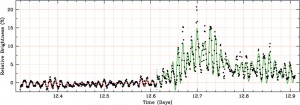Observations of two cool white dwarfs show irregular outbursts in the stars’ otherwise steady rhythm of pulsations.

ESA / NASA
Hiccups are what come to mind when I think about the behavior astronomers have seen for the first time in two pulsating white dwarf stars. Pulsating white dwarfs, or ZZ Cetis, are a type of white dwarf that glows and fades in a steady rhythm. They can be as dependable as clocks. But J. J. Hermes (University of Warwick, UK), Keaton Bell (University of Texas at Austin), and colleagues report in the August 10th Astrophysical Journal and September 1st Astrophysical Journal Letters that they’ve observed huge, irregular outbursts of light from two of these normally rhythmic stars.
Astronomers have studied pulsating white dwarf stars since the 1960s. Using a star’s spectrum and the variation in its brightness over time, they’re able to constrain the star’s mass, radius, rotation, chemical composition, and internal structure. However, because the world turns (and because we have weather), scientists have only ever been able to study these stars’ behavior by piecing together individual, clear nights of data from Earth-bound telescopes. Gaps are inevitable.
Hermes and his colleagues realized they could observe ZZ Cetis with far fewer interruptions using the Kepler space telescope. The Kepler spacecraft trails after Earth in an orbit around the Sun. Its original mission was to stare nearly continuously at a patch of sky near the Cygnus constellation and monitor the brightness of about 150,000 stars (a few of them ZZ Cetis) in a search for exoplanets.
However, when one of Kepler’s reaction wheels froze up, the telescope could no longer reliably hold its previous position. Kepler steered its gaze to the galactic ecliptic plane and now re-adjusts its position every 82 days or so, stabilizing itself with its two remaining reaction wheels and radiation pressure from the Sun. Rather than monitoring all the stars in one fixed region of the sky, the K2 mission observed targets in several different fields of view, including some pulsating white dwarfs.
The astronomers hoped to use these observations to understand more about what happens in the hot, extremely dense core of a ZZ Ceti. They especially wanted to know why these stars stop pulsating once they cool below about 10,800 kelvin (18,400°F). Ordinary white dwarfs become pulsating white dwarfs when those that have a hydrogen atmosphere cool from an initial temperature of around 100,000K to about 12,600K (the Sun’s visible surface is only about 6,000K). Their hydrogen atmosphere becomes a mix of ionized and neutral hydrogen atoms, and this mix of atoms stores and releases energy in regular intervals of a few minutes, which drives pulsations that resonate through the star. These make the white dwarf brighten and fade by a few percent in regular beats, like a person’s breath, at a set of frequencies and intensities set by the geometry of the star. The star continues to cool slowly over time and, once it falls below about 10,800K, ceases pulsating altogether.
Using Kepler data, the team tracked one pulsating white dwarf, KIC 4552982, for over a year and a half, the longest any ZZ Ceti has been (almost) continuously observed. In the extended Kepler mission, the team observed a second white dwarf, PG 1149+057, for two and a half months (the longest Kepler can now stare at any single field). The temperatures of the two stars are both about 11,000K, cooler than most pulsating white dwarfs previously studied and a few hundred degrees above the shutdown temperature for pulsation.

J. J. Hermes / Univ. of Warwick / NASA
But hiccups interrupted the dwarfs’ otherwise even breaths. Shooting high above the expected crests and falls in brightness every few minutes appeared sporadic outbursts of brightness lasting several hours. The regular pulsations changed the stars' brightness by 1% to 3%, but KIC 4552982’s outbursts were 2% to 17% above the norm, and PG 1149+057’s hiccups spiked up to 45% above the star’s mean brightness. No ZZ Ceti observed before had shown this behavior.
Bell, Hermes, and their collaborators think the outbursts affect the distribution of pulsation frequencies measured in the two stars. Though the cause of the outbursts is uncertain, the researchers also think there is a possibility that these hiccups in brightness are more like last gasps and precede the eventual shutdown of pulsations in cool white dwarf stars.
There are many more ZZ Cetis for the Kepler telescope to observe in future campaigns of the K2 mission. As long as the telescope continues to function (fingers crossed), astronomers will be able to keep studying the seismology of the pulsating white dwarfs within Kepler’s gaze. If astronomers observe more outbursts from ZZ Cetis, it may help us understand why these stars get the hiccups.
References:
K. J. Bell et al. "KIC 4552982: Outbursts and Asteroseismology from the Longest Pseudo-Continuous Light Curve of a ZZ Ceti." Astrophysical Journal. August 10, 2015.
J. J. Hermes et al. "A Second Case of Outbursts in a Pulsating White Dwarf Observed by Kepler." Astrophysical Journal Letters. September 1, 2015.
Learn to navigate the night sky with our star wheels.
 1
1
Comments
Anthony Barreiro
September 21, 2015 at 3:26 pm
This is interesting work.
One small clarification: the ecliptic plane is inclined about 62 degrees relative to the galactic equatorial plane. The ecliptic crosses the galactic equator in Sagittarius on one side of the Earth's orbit and at the border of Taurus and Gemini on the other side, but between these two points the ecliptic travels far south and north of the galactic equator. Since the K2 mission will be observing in the ecliptic plane, there will be times when the telescope is looking at the galactic plane, but most of the time it will be looking north or south of the galactic plane.
You must be logged in to post a comment.
You must be logged in to post a comment.